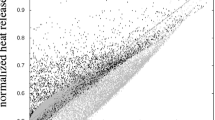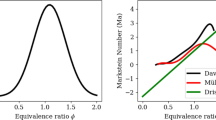Abstract
The conventional multi-scale modelling approach that predicts carbon nanotube (CNT) growth region in heterogeneous flame environment is computationally exhaustive. Thus, the present study is the first attempt to develop a zero-dimensional model based on existing multi-scale model where mixture fraction z and the stoichiometric mixture fraction \(z_{st}\) are employed to correlate burner operating conditions and CNT growth region for diffusion flames. Baseline flame models for inverse and normal diffusion flames are first established with satisfactory validation of the flame temperature and growth region prediction at various operating conditions. Prior to developing the correlation, investigation on the effects of \(z_{st}\) on CNT growth region is carried out for 17 flame conditions with \(z_{st}\) of 0.05 to 0.31. The developed correlation indicates linear (\(z_{lb}\)=1.54\(z_{st}\)+0.11) and quadratic (\(z_{hb}\)=\(z_{st}\)(7-13\(z_{st}\))) models for the \(z_{lb}\) and \(z_{hb}\) corresponding to the low and high boundaries of mixture fraction, respectively, where both parameters dictate the range of CNT growth rate (GR) in the mixture fraction space. Based on the developed correlations, the CNT growth in mixture fraction space is optimum in the flame with medium-range \(z_{st}\) conditions between 0.15 and 0.25. The stronger relationship between growth-region mixture-fraction (GRMF) and \(z_{st}\) at the near field region close to the flame sheet compared to that of the far field region away from the flame sheet is due to the higher temperature gradient at the former region compared to that of the latter region. The developed models also reveal three distinct regions that are early expansion, optimum, and reduction of GRMF at varying \(z_{st}\).








Similar content being viewed by others
References
Yang M, Chen Y, Wang H, Zou Y, Wu P, Zou J, Jiang J (2022) Solvothermal preparation of CeO2 nanoparticles-graphene nanocomposites as an electrochemical sensor for sensitive detecting pentachlorophenol. Carbon Lett 32(5):1277–1285
Chen Y, Tu C, Liu Y, Liu P, Gong P, Wu G, Huang X, Chen J, Liu T, Jiang J (2023) Microstructure and mechanical properties of carbon graphite composites reinforced by carbon nanofibers. Carbon Lett 33(2):561–571
Yang M, Zou Y, Ding L, Yu Y, Ma J, Li L, Rafryanto AF, Zou J, Arramel Wang H (2023) Tio2 nanoparticles anchored on graphene oxide nanosheets as a highly active photocatalyst for decabromodiphenyl ether degradation. Carbon Lett 1–9
Rathinavel S, Priyadharshini K, Panda D (2021) A review on carbon nanotube: an overview of synthesis, properties, functionalization, characterization, and the application. Mater Sci Eng B 268:115095
Anzar N, Hasan R, Tyagi M, Yadav N, Narang J (2020) Carbon nanotube-a review on synthesis, properties and plethora of applications in the field of biomedical science. Sens Int 1:100003
Liu Y-P, Xu C-X, Ren W-Q, Hu L-Y, Fu W-B, Wang W, Yin H, He B-H, Hou Z-H, Chen L (2022) Self-template synthesis of peapod-like mno@ n-doped hollow carbon nanotubes as an advanced anode for lithium-ion batteries. Rare Metals 1–11
Xu C, Li S, Hou Z, Yang L, Fu W, Wang F, Kuang Y, Zhou H, Chen L (2023) Direct pyrolysis to convert biomass to versatile 3d carbon nanotubes/mesoporous carbon architecture: conversion mechanism and electrochemical performance. Front Chem Sci Eng 1–12
Hamzah N, Yasin MFM, Yusop MZM, Saat A, Subha NM (2017) Rapid production of carbon nanotubes: a review on advancement in growth control and morphology manipulations of flame synthesis. J Mater Chem A 5(48):25144–25170
Heng EW, Zainal MT, Yasin MFM, Hamzah N (2019) Effects of flame structure and flame strain on the growth region of carbon nanotubes in counter-flow diffusion flame. CFD Lett 11(6):72–85
Radue M, Odegard GM (2018) Multiscale modeling of carbon fiber/carbon nanotube/epoxy hybrid composites: Comparison of epoxy matrices. Compos Sci Technol 166:20–26
Hamzah N, Yasin MFM, Yusop MZM, Haniff MASM, Hasan MF, Tamrin KF, Subha NAM (2020) Effect of fuel and oxygen concentration toward catalyst encapsulation in water-assisted flame synthesis of carbon nanotubes. Combust Flame 220:272–287
Zainal M, Yasin MFM, Wahid MA (2016) Investigation of the coupled effects of temperature and partial pressure on catalytic growth of carbon nanotubes using a modified growth rate model. Mater Res Express 3(10):105040
Li Z, Xiong K, Sun Y, Chen X, He J, Zhang S, Fu Y, Mao Y (2020) First-principles investigations of structural, elastic, thermodynamic and electronic properties of pt3hf compound under pressure. In: IOP Conference Series: Mater Sci Eng 733:012030. IOP Publishing
Li H, Gong Y, Fu C, Zhou H, Yang W, Guo M, Li M, Kuang Y (2017) A novel method to prepare a nanotubes@ mesoporous carbon composite material based on waste biomass and its electrochemical performance. J Mater Chem A 5(8):3875–3887
Wu J, Liang K, Yang C, Zhu J, Liu D (2019) Synthesis of carbon nanotubes on metal mesh in inverse diffusion biofuel flames. Fuller Nanotubes Carbon Nanostr 27(1):77–86
Unrau C, Axelbaum R, Biswas P, Fraundorf P (2007) Synthesis of single-walled carbon nanotubes in oxy-fuel inverse diffusion flames with online diagnostics. Proceed Combust Inst 31(2):1865–1872
Unrau CJ, Axelbaum RL, Fraundorf P (2010) Single-walled carbon nanotube formation on iron oxide catalysts in diffusion flames. J Nanoparticle Res 12(6):2125–2133
Kharlamova MV (2017) Investigation of growth dynamics of carbon nanotubes. Beilstein J Nanotechnol 8(1):826–856
Hu W-C, Hou S-S, Lin T-H (2017) Transition of carbon nanostructures in heptane diffusion flames. J Nanoparticle Res 19(2):1–11
Hamzah N, Yasin MFM, Yusop MZM, Saat A, Subha NM (2019) Growth region characterization of carbon nanotubes synthesis in heterogeneous flame environment with wire-based macro-image analysis. Diamond Relat Mater 99:107500
Qin J, Wang C, Yao Z, Ma Z, Cui X, Gao Q, Wang Y, Wang Q, Wei H (2021) Influencing factors and growth kinetics analysis of carbon nanotube growth on the surface of continuous fibers. Nanotechnology 32(28):285702
Edgeworth J, Burt D, Dobson P, Weaver J, Macpherson J (2010) Growth and morphology control of carbon nanotubes at the apexes of pyramidal silicon tips. Nanotechnology 21(10):105605
Li L, Zainal MT, Yasin MFM, Hamzah N, Sies MM, Yazid MNAWM, Amzin S, Supee A (2021) The influences of oxygen concentration and external heating on carbon nanotube growth in diffusion flame. CFD Lett 13(12):45–62
Cui X, Song B, Cheng S, Xie Y, Shao Y, Sun Y (2017) Synthesis of carbon nanotube (cnt)-entangled cuo nanotube networks via cnt-catalytic growth and in situ thermal oxidation as additive-free anodes for lithium ion batteries. Nanotechnology 29(3):035603
Hou S-S, Huang W-C, Lin T-H (2012) Flame synthesis of carbon nanostructures using mixed fuel in oxygen-enriched environment. J Nanoparticle Res 14(11):1–11
Chen Y, Wang J, Li C, Zhang X (2021) Development and verification of the new simplified mechanism for Ch4/O2/Co2 laminar premixed flame under high pressure. ACS Omega 6(29):18559–18565
Zainal MT, Yasin MFM, Wahid MA (2016) Optimizing flame synthesis of carbon nanotubes: experimental and modelling perspectives. J Teknologi 78:133–145
Zainal M, Yasin MFM, Wahid MA, Sies MM (2021) A flame structure approach for controlling carbon nanotube growth in flame synthesis. Combust Sci Technol 193(8):1326–1342
Hamzah N, Yasin MM, Zainal M, Sies MM, Yusop MM, Chong C, Subha NM, Rosmi MR (2021) Morphology and growth region analysis of carbon nanotubes growth in water-assisted flame synthesis. Combust Sci Technol 1–18
Gamboa A, Marques L, Fernandes E (2021) Electric field assisted mass production of carbon nanotubes on 303l stainless steel. Diamond Relat Mater 113:108274
Zhang C, Tian B, Chong CT, Ding B, Fan L, Chang X, Hochgreb S (2022) Experimental study of thiophene and ferrocene in synthesis of single-walled carbon nanotubes in rich premixed hydrogen/air flames. Combust Flame 238:111939
Rahman G, Najaf Z, Mehmood A, Bilal S, Shah AHA, Mian SA, Ali G (2019) An overview of the recent progress in the synthesis and applications of carbon nanotubes. C - J Carbon Res 5(1):3
Acknowledgements
This research was supported by Ministry of Education (MOE) through the Fundamental Research Grant Scheme (FRGS/1/2020/TK0/UTM/02/54) with cost center number R.J130000.7851.5F377. The research is also funded by Universiti Teknologi Malaysia (UTM) through UTM Fundamental Research (UTMFR: PY/2019/01657) grant with cost center number Q.J130 0 0 0.2551.21H10.
Author information
Authors and Affiliations
Corresponding author
Additional information
Publisher's Note
Springer Nature remains neutral with regard to jurisdictional claims in published maps and institutional affiliations.
Rights and permissions
Springer Nature or its licensor (e.g. a society or other partner) holds exclusive rights to this article under a publishing agreement with the author(s) or other rightsholder(s); author self-archiving of the accepted manuscript version of this article is solely governed by the terms of such publishing agreement and applicable law.
About this article
Cite this article
Zainal, M.T., Hamzah, N., Abdul Wahid, M. et al. Zero-dimensional model for the prediction of carbon nanotube (CNT) growth region in heterogeneous methane-flame environment. Carbon Lett. 33, 2199–2210 (2023). https://doi.org/10.1007/s42823-023-00579-z
Received:
Revised:
Accepted:
Published:
Issue Date:
DOI: https://doi.org/10.1007/s42823-023-00579-z




